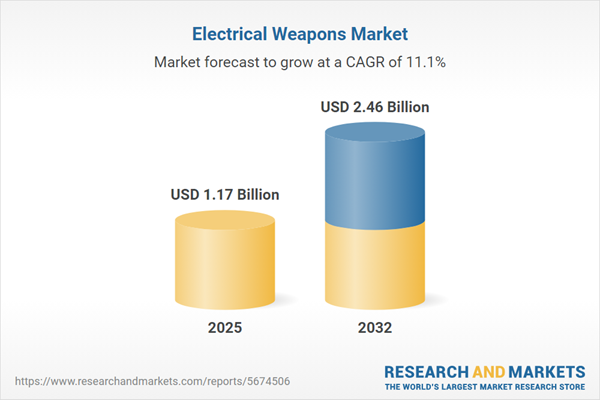Speak directly to the analyst to clarify any post sales queries you may have.
The electrical weapons market is transforming as organizations across sectors seek advanced, nonlethal tools for operational challenges and compliance. Senior decision-makers require actionable insights to optimize procurement, risk management, and response strategies amid evolving regulatory and technological demands.
Market Snapshot: Electrical Weapons Market Size, Growth, and Dynamics
The electrical weapons market is projected to reach USD 2.46 billion by 2032, growing from USD 1.05 billion in 2024 with a compound annual growth rate (CAGR) of 11.13%. Market momentum is fueled by rising demand for nonlethal solutions that help organizations maintain safety, compliance, and agility in complex operational contexts. As responsible force application becomes a priority, suppliers are advancing product functionality to comply with diverse regulations. Competitive differentiation focuses on local compliance, product adaptability, and support for various security operations across global markets.
Scope & Segmentation: Comprehensive Market Breakdown
- Product Types: Acoustic weapon systems support crowd management; net launcher devices provide non-contact restraint options; pepper spray products facilitate immediate deterrence; batons contribute to traditional compliance needs; handheld stun guns and Tasers, including drive-stun and remote-probe types, enable targeted intervention for law enforcement and security operations.
- Applications: Key uses include daily deterrence and crisis response in law enforcement, structured inmate handling for corrections, peacekeeping and support in military contexts, and organization-specific solutions for civilian and private security requirements.
- Technologies: The sector spans pulse-driven systems, long-range acoustic devices, and electroshock platforms. Supplementary technologies—such as chemical deterrents like tear gas and foam—expand capabilities, while digital sensors and monitoring enhance transparency and reporting for compliance and oversight.
- End Users: Government agencies, military units, private security firms, and certified civilian organizations require tailored solutions aligned with their particular mandates and environments, focusing on operational fit and compliance.
- Distribution Channels: Direct sales channels address institutional needs for customized engagement; OEM partnerships facilitate specification-based supply; specialty retailers and online channels provide flexible procurement options; robust supply chains sustain readiness across markets.
- Regions: North America emphasizes integration of advanced technology and strict regulatory adherence; Latin America reflects changing security priorities; Europe prioritizes high compliance; Middle East and Africa benefit from adaptable supply models; Asia-Pacific demands flexible production to meet varied policy landscapes.
- Key Companies Analyzed: Major players advancing research and supply resilience include Axon Enterprise, Safariland Group, Combined Systems, Raytheon Technologies, Lockheed Martin, Boeing, BAE Systems, Northrop Grumman, Leonardo S.p.A., and Rheinmetall AG.
Key Takeaways: Strategic Insights for Senior Decision-Makers
- Electrical weapons support responsible force standards, helping organizations balance operational control with risk mitigation in diverse environments.
- The demand for devices featuring integrated transparency, automated tracking, and advanced reporting is reshaping procurement priorities and enhancing institutional oversight.
- Adoption of digital monitoring and real-time sensors drives improvements in incident response and post-event analysis, strengthening operational procedures and accountability mechanisms.
- Regional procurement strategies differ: North American and European markets target technology integration and regulatory fit, while Asia-Pacific favors flexible manufacturing and nuanced local compliance.
- Collaboration among agencies, manufacturers, and technology firms supports adaptive regulatory response and enhances sector growth via knowledge sharing and innovation.
- Strengthening distribution networks and increasing production scalability allows suppliers to address shifting buyer needs and ensure continuity within changing supply-chain environments.
Tariff Impact: U.S. Measures and Global Supply Chains
Upcoming U.S. tariffs for 2025 are prompting manufacturers to adjust sourcing and production. Strategies include diversifying suppliers, modular design implementation, and increasing domestic assembly. Enhanced partnerships with logistics and distribution firms support stable supply chains, allow ongoing market access, and ensure swift adaptation to evolving trade regulations and global competition.
Methodology & Data Sources
This analysis draws on regulatory insights, in-depth equipment assessments, and interviews with law enforcement, defense, and academic experts. The multifaceted approach ensures findings align with both operational needs and verifiable market developments, enhancing credibility for senior decision-makers.
Why This Report Matters to Senior Decision-Makers
- Equips procurement leaders with strategies to optimize supplier selection, reinforce risk management frameworks, and maintain reliable partnerships under changing compliance and technology benchmarks.
- Offers actionable recommendations for aligning protocols with shifting operational and regulatory standards amid sector transformation.
- Supplies detailed supplier evaluation criteria that support organizations in strengthening resilience and maintaining competitiveness in light of regulatory and technological advancement.
Conclusion: Navigating the Electrical Weapons Market
Senior leaders can use these findings to sharpen supplier assessments, advance compliance strategies, and manage risk effectively within a rapidly evolving electrical weapons market.
Additional Product Information:
- Purchase of this report includes 1 year online access with quarterly updates.
- This report can be updated on request. Please contact our Customer Experience team using the Ask a Question widget on our website.
Table of Contents
3. Executive Summary
4. Market Overview
7. Cumulative Impact of Artificial Intelligence 2025
Companies Mentioned
The companies profiled in this Electrical Weapons market report include:- Axon Enterprise, Inc.
- Safariland Group, LLC
- Combined Systems, Inc.
- Raytheon Technologies Corporation
- Lockheed Martin Corporation
- The Boeing Company
- BAE Systems PLC
- Northrop Grumman Corporation
- Leonardo S.p.A.
- Rheinmetall AG
Table Information
| Report Attribute | Details |
|---|---|
| No. of Pages | 198 |
| Published | November 2025 |
| Forecast Period | 2025 - 2032 |
| Estimated Market Value ( USD | $ 1.17 Billion |
| Forecasted Market Value ( USD | $ 2.46 Billion |
| Compound Annual Growth Rate | 11.1% |
| Regions Covered | Global |
| No. of Companies Mentioned | 11 |









